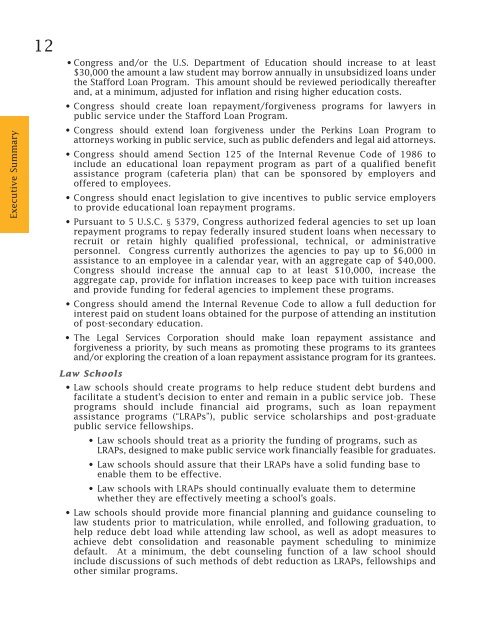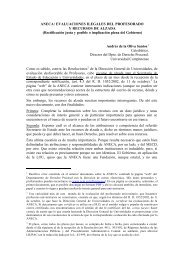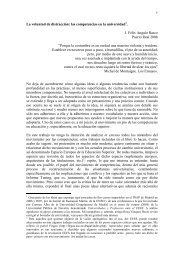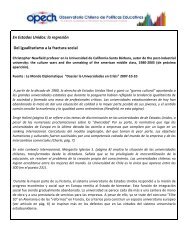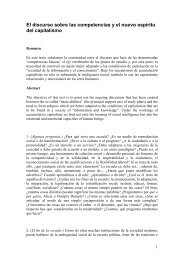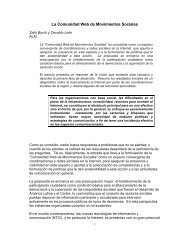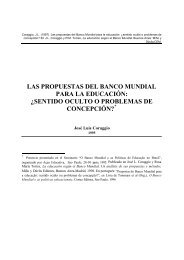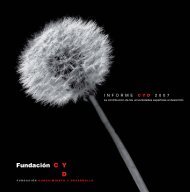Lifting the Burden: Law Student Debt as a Barrier to Public Service
Lifting the Burden: Law Student Debt as a Barrier to Public Service
Lifting the Burden: Law Student Debt as a Barrier to Public Service
Create successful ePaper yourself
Turn your PDF publications into a flip-book with our unique Google optimized e-Paper software.
Executive Summary12• Congress and/or <strong>the</strong> U.S. Department of Education should incre<strong>as</strong>e <strong>to</strong> at le<strong>as</strong>t$30,000 <strong>the</strong> amount a law student may borrow annually in unsubsidized loans under<strong>the</strong> Stafford Loan Program. This amount should be reviewed periodically <strong>the</strong>reafterand, at a minimum, adjusted for inflation and rising higher education costs.• Congress should create loan repayment/forgiveness programs for lawyers inpublic service under <strong>the</strong> Stafford Loan Program.•Congress should extend loan forgiveness under <strong>the</strong> Perkins Loan Program <strong>to</strong>at<strong>to</strong>rneys working in public service, such <strong>as</strong> public defenders and legal aid at<strong>to</strong>rneys.• Congress should amend Section 125 of <strong>the</strong> Internal Revenue Code of 1986 <strong>to</strong>include an educational loan repayment program <strong>as</strong> part of a qualified benefit<strong>as</strong>sistance program (cafeteria plan) that can be sponsored by employers andoffered <strong>to</strong> employees.• Congress should enact legislation <strong>to</strong> give incentives <strong>to</strong> public service employers<strong>to</strong> provide educational loan repayment programs.• Pursuant <strong>to</strong> 5 U.S.C. § 5379, Congress authorized federal agencies <strong>to</strong> set up loanrepayment programs <strong>to</strong> repay federally insured student loans when necessary <strong>to</strong>recruit or retain highly qualified professional, technical, or administrativepersonnel. Congress currently authorizes <strong>the</strong> agencies <strong>to</strong> pay up <strong>to</strong> $6,000 in<strong>as</strong>sistance <strong>to</strong> an employee in a calendar year, with an aggregate cap of $40,000.Congress should incre<strong>as</strong>e <strong>the</strong> annual cap <strong>to</strong> at le<strong>as</strong>t $10,000, incre<strong>as</strong>e <strong>the</strong>aggregate cap, provide for inflation incre<strong>as</strong>es <strong>to</strong> keep pace with tuition incre<strong>as</strong>esand provide funding for federal agencies <strong>to</strong> implement <strong>the</strong>se programs.• Congress should amend <strong>the</strong> Internal Revenue Code <strong>to</strong> allow a full deduction forinterest paid on student loans obtained for <strong>the</strong> purpose of attending an institutionof post-secondary education.• The Legal <strong>Service</strong>s Corporation should make loan repayment <strong>as</strong>sistance andforgiveness a priority, by such means <strong>as</strong> promoting <strong>the</strong>se programs <strong>to</strong> its granteesand/or exploring <strong>the</strong> creation of a loan repayment <strong>as</strong>sistance program for its grantees.<strong>Law</strong> Schools• <strong>Law</strong> schools should create programs <strong>to</strong> help reduce student debt burdens andfacilitate a student’s decision <strong>to</strong> enter and remain in a public service job. Theseprograms should include financial aid programs, such <strong>as</strong> loan repayment<strong>as</strong>sistance programs (“LRAPs”), public service scholarships and post-graduatepublic service fellowships.• <strong>Law</strong> schools should treat <strong>as</strong> a priority <strong>the</strong> funding of programs, such <strong>as</strong>LRAPs, designed <strong>to</strong> make public service work financially fe<strong>as</strong>ible for graduates.• <strong>Law</strong> schools should <strong>as</strong>sure that <strong>the</strong>ir LRAPs have a solid funding b<strong>as</strong>e <strong>to</strong>enable <strong>the</strong>m <strong>to</strong> be effective.• <strong>Law</strong> schools with LRAPs should continually evaluate <strong>the</strong>m <strong>to</strong> determinewhe<strong>the</strong>r <strong>the</strong>y are effectively meeting a school’s goals.• <strong>Law</strong> schools should provide more financial planning and guidance counseling <strong>to</strong>law students prior <strong>to</strong> matriculation, while enrolled, and following graduation, <strong>to</strong>help reduce debt load while attending law school, <strong>as</strong> well <strong>as</strong> adopt me<strong>as</strong>ures <strong>to</strong>achieve debt consolidation and re<strong>as</strong>onable payment scheduling <strong>to</strong> minimizedefault. At a minimum, <strong>the</strong> debt counseling function of a law school shouldinclude discussions of such methods of debt reduction <strong>as</strong> LRAPs, fellowships ando<strong>the</strong>r similar programs.


